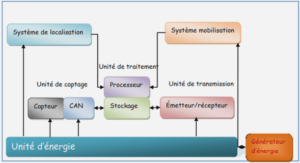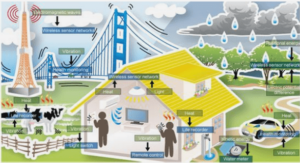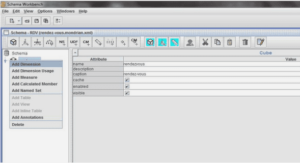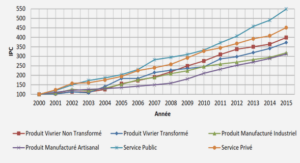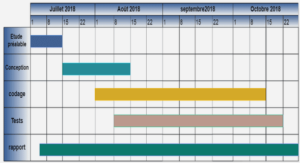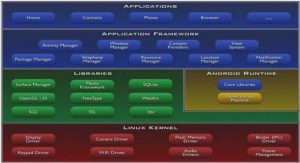Télécharger le fichier pdf d’un mémoire de fin d’études
Delayed CSIT in erasure broadcast channel (EBC) and GBC
Across the independent works [27, 28], the capacity region of the EBC with causal state feedback was fully determined in the three-user case and partially characterized for K > 3 cases. The main idea behind the schemes proposed in these references is fundamentally the same: the source first sends out the uncoded packets, then generates according to the state feedback some adequate “linear combinations” of the packets that are lost by certain receivers but overheard by some others and multicast these linear combinations to certain corresponding receivers. Given that sufficient linearly independent combinations are available to each receiver, the desired packets (messages) are always ready to be recovered.
However, the schemes in [27, 28] only work for a packet alphabet of size 2q with q 2 N such that 2q K. This is to guarantee the existence of a desired number of linearly independent vectors in the corresponding vector space. As a consequence, the capacity region is still open for other input alphabet sizes. Essentially, there is striking similarity between the MAT scheme and the schemes described in [27,28]. Specifically, the MAT scheme follows the routine as: first send out the signal uncoded, then create based on the CSI feedback and multicast the linear combinations of the overheard signals, so that the messages can be easily recovered, e.g., by Gaussian elimination, with vanishing decoding error if enough equations are available to each user. Besides, there is a resemblance between the DoF region of GBC and the capacity region of EBC. As a matter of fact, such similarity also occurred between the secure DoF/rate regions of GBC/EBC as shown in [29, 30].
Heterogeneous feedback
As claimed previously, the interference mitigation techniques might not be efficient in physical channels if we let it stand alone by excluding the concerns on limited power and/or heterogeneity. Motivated by this, we consider the RIA under the heterogeneous state feedback condition. For convenience, we state briefly the definition of homogeneous/heterogeneous state feedback specifically for this thesis. All the communicating nodes participate in the feedback process when we assume homogeneous feedback, e.g., as shown in Fig 1. In contrast, heterogeneous state feedback is defined as only part of the communicating nodes participates in the state feedback process; whereas homogeneous state feedback means that the delayed CSI of all the destinations are feedback to all transmitters. To be specific, we give two examples to illustrate distinct heterogeneous state feedback. The first instance is that the feedback heterogeneity lies in the receivers’ side, that is, some of the receivers feedback their delayed CSI to all the senders while no feedback from others are detected, e.g., as shown in Fig 2. In this case, the source does not grasp the status of the whole system and has to design its transmission based on the partial/heterogeneous state. The second example is when the heterogeneity locates at the transmitters’ side, i.e., though all the users send back their states, merely few transmitters are capable of collecting the feedback information because of either the inferior quality of feedback link or the protocol settings.2 One of the examples is shown in Fig 3. Even though heterogeneities can happen simultaneously at both ends of communication, for clarity purpose, we omit such definition.
State feedback from partial receiver(s) Hybrid CSIT represents that states about distinct source-destination channel (SDC) available to the transmitter are of different qualities, e.g., delayed CSIT (‘D’), no CSIT (‘N’), perfect and instantaneous state at the source (‘P’). As it is ubiquitous and general, hybrid CSIT, including heterogeneous state feedback as special cases, is of practical significance and has been extensively studied with a special emphasis on DoF [7, 11, 31–37]. Although we verified in [38–40] the performance gain with DD state at almost all applicable SNRs, the improvement is shown to vanish even in high SNR regimes and the DoF collapse to unity when the system subjects to PN state [41], let alone the DN case (two user heterogeneous feedback). In other words, from DoF’s perspective, introducing a user into a point-to-point channel with perfect/delayed CSIT is not beneficial if the CSI of new user is missing. Similar results have been reported in [36] for beyond two user cases. The sum DoF of three user BC with state DDN and state PDN are limited to 43 and 32 which coincides with the optimal DoF of two user case with state DD [2] and PD [42], respectively.
Owing to the similarity (or we can call it uniformity) between the DoF region of GBC and the capacity of EBC in DD case, it sounds reasonable to predict a degraded capacity in EBC with DN state given the inferior DoF performance. Quite surprisingly, Lin and Wang proved in [43, 44] that the CSI feedback from a single user can still be useful when a symmetric spatially independent EBC is investigated. To see this, they proposed a multiple phase algorithm which is capable of exploiting an opportunistic coding gain by linear network coding. The essential ingredient of the approach lies in that the transmitter XORs the intended but erased bits and the undesired but observed bits at one user (the one provides D state), sends them as side information, and let both user decodes wanted bits opportunistically along with the previously overheard bits. Encouraged by that, we investigated the BC with feedback heterogeneity at receivers’ side. In fact, authors of [43, 44] are not the only researchers who notice the potential of heterogeneous state feedback. In particular, [41, 45, 46] took a finite state BC with additive white Gaussian noise (AWGN) as a counter example to the degraded performance conjecture for general probability mass function (pmf), i.e., a sum DoF strictly bounded away from unity is shown in [47, 48] to be achievable for DN state. Regardless of the difference on coding tools employed in [43, 44, 47, 48], the idea behind is consistent. The source encodes the side information only dependent on the partial state while the receiver knows both state so that it can decide which part to decode based on whether the corresponding state realization does conform to that in DD’s scheme, e.g., receiver 2 decides to decode auxiliary bits whose states are (S1, S2) = (1, 0) because these bits are desired by user 2 and are encoded into the side information.
State feedback to partial transmitter(s)
Given that dense BSs subject to distinct standards are deployed in the network, it is intuitive to introduce cooperation between multiple-tier BSs via wired (dis-tributed antenna system with backhaul) or wireless (relaying) links to guarantee a coherent transmission. Thus, we consider a typical heterogeneous network setup in which a macrocell BS serves two users who are in close proximity to a smallcell (e.g., femto/pico) BS. A natural question here is whether and how smallcell BS could improve downlink performance of the macrocell network. Essentially, the smallcell BS in this setting may be considered as a relay, and the overall channel becomes a broadcast relay channel (BRC).
We revisit the main idea of MAT, which consists in two phases: 1) the broadcast phase in which signal containing new messages is sent to the receivers, and 2) the multicast phase in which side information generated based on both the past channel and the sent messages is diffused. It is therefore instinctive to think of the transmitter as two separate virtual transmitters: one takes charge of the first phase without the need of any CSIT, whereas the other is responsible for the second phase and uses the delayed CSIT and the transmitted message. The second virtual transmitter is very much like a relay that “learns” the messages and the channel coefficients and “forwards” the necessary side information to “help” the receivers decode their own messages.
With the above reasoning, in Chapter 5, we deploy an infrastructure relay that helps accomplish the RIA a la MAT with the heterogeneous state feedback from every mobiles to the smallcell BS (relay) instead to the macrocell BS (source). Our setting on feedback is mainly inspired by the fact that feeding back CSI accurately to the macrocell BS via uplink is costly in practice. The cost is in terms of both the uplink bandwidth and the uplink transmit power related to the feedback. Since the relay is assumed to be closer to the destinations than the source is, feedback to the relay instead may be more feasible. In other words, the feedback communication is localized and the feedback power could be reduced thanks to lower channel attenuation.
In the next several sections, we introduce three channel models that will be studied in this thesis, i.e., BC with homogeneous state feedback, BC with heterogeneous state feedback and BRC with state feedback at the relay. With respect to the length of a dissertation, reviewing all the related works does not seem to be feasible. Therefore, we present the most relevant results in the channel models that are investigated.
BROADCAST CHANNEL WITH HOMOGENEOUS STATE FEEDBACK
As a first step to verify the potential improvement with RIA at finite SNR, we choose the possibly simplest model in the network coding problem, namely, the BC. We will study the BC with homogeneous state feedback in Chapter 2 and 3. The channel is a memoryless state-dependent K-user BC through which the source wishes to communicate with the help of state feedback from all destinations, in n channel uses, K independent messages to the K receivers, respectively. The channel can be described by the joint pmf, pY1, ,YK jX,S(y1, . . . , yK jx, s)pS(s) = Õ pY1, ,YK jX,S(y1i, . . . , yKijxi, si)pS(si), (1) i=1 where x 2 X n, yk 2 Ykn, and s 2 Sn for all k 2 K , f1, 2, , Kg are the sequences of the channel input, the k-th channel output, and the channel state, respectively. X , Y, S are the alphabets of the channel input, the channel output, and the state, respectively. The global channel state information is known instantaneously to all the receivers, e.g., each user has access to all the error events of EBC or all the channel coefficients of GBC immediately after the transmissions. At the transmitter’s side, the channel state is known strictly causally without error, e.g., via a noiseless feedback link. Unless it is stated otherwise, the cost of the state feedback is not taken into account throughout the dissertation as we assume sufficient resource is allocated to guarantee an unbounded feedback rate. For brevity, we assume that the state information is provided at the transmitter with one slot delay and the channel itself is temporally independent and identically distributed (i.i.d.). The details of the channel model is shown in Fig. 4.
Similar to the no feedback case, the capacity of BC with feedback is fully characterized in physically degraded case [4] but is still unknown in general. Dueck illustrated in [3] that feedback can enlarge the capacity region for some classes of BC by letting the source broadcast CSI of common interest to both receivers. Ever since, some remarkable works have been reported, e.g., [20,22,49,50] and reference therein, amongst which [20] provides a most relevant region to our work. In particular, Shayevitz and Wigger studied the two-user broadcast channel with generalized feedback and proposed an achievable rate region, quoted hereafter as Shayevitz-Wigger (SW) region, based on double binning and block Markov coding techniques in a separate source-channel coding framework. Albeit the relevance, one shall note that we will focus on the state feedback whereas their work concentrated on generalized feedback.
In the next two subsections, two subclass channels of BC are defined in which we illustrate how the homogeneous state feedback is exploited in these channels.
Fading Gaussian broadcast channel
The Gaussian channel is employed frequently in research as it captures the main properties of wireless communications. The capacity region of the GBC is known when the channel state is deterministic [51, 52]. When the channel is subject to fading unknown to the transmitter (no CSIT), the capacity is still open except for some particular fading processes such as the case when both users experience the exact same fading distribution [53]. For more general cases, only high SNR characterizations in terms of DoF are available in the literature.
BROADCAST CHANNEL WITH HETEROGENEOUS STATE FEEDBACK
We investigate the BC with heterogeneous state feedback in Chapter 4. The model we are interested in is similar to that defined in Section 1.2 in the sense that both systems consist of a single source, multiple destinations, and a BC via which K independent messages from the source are conveyed to the intended destination. The difference lies in the state information known to the source. In this channel, we divide the state set into two parts as S = (SJ , SJ¯ ), where J¯ , K n J and SJ¯ is the complement of state set SJ .
The state information are available heterogeneously to the distinct nodes. In particular, the destinations are aware of the global state information instanta-neously. On the contrary, only part of the outdated CSI, namely SJ , is learned by the transmitter, e.g., the users in set J feedback their states to the source. The detailed system model is depicted in Fig. 6.
|
Table des matières
1 Introduction and Preliminaries
1.1 Motivation
1.1.1 Delayed CSIT at finite SNR
1.1.2 Delayed CSIT in EBC and GBC
1.1.3 Heterogeneous feedback
1.2 Broadcast Channel with Homogeneous State Feedback
1.2.1 Fading Gaussian broadcast channel
1.2.2 Erasure broadcast channel
1.3 Broadcast Channel with Heterogeneous State Feedback
1.3.1 Linear coding in EBC with heterogeneous state feedback
1.4 Broadcast Relay Channel with State Feedback at Relay
1.4.1 Modelization from practical wireless system
1.4.2 General memoryless two-user BRC
1.4.3 Fading Gaussian noise BRC
1.5 Thesis Outline
1.6 List of Publications
I Broadcasting with Homogeneous State Feedback
2 An achievable rate region of the two-user BC with State Feedback
2.1 Overview
2.2 Main Results
2.2.1 Achievable rate region
2.2.2 Outer bound
2.3 Gaussian MISO BC and Numerical Results
2.3.1 Inner bound in Gaussian case
2.3.2 Outer bound in Gaussian case
2.3.3 Numerical results
2.4 Closing Remarks
2.A Proof of Theorem 2.1
2.A.1 Codebook generation
2.A.2 Encoding
2.A.3 Decoding and error events
2.A.4 Error events analysis
3 K user BC with State Feedback: Distributed Compression method
3.1 Overview
3.2 Main Results
3.2.1 RVs and general region
3.2.2 Achievable region in EBC
3.2.3 Symmetric rate and DoF of fading GBC
3.3 Description of the Proposed Scheme
3.4 Numerical Example
3.4.1 Setup and references
3.4.2 Numerical evaluation
3.5 Summary and Closing Remarks
3.A Sketch of Proof of Corollary 3.2
3.B Proof of Proposition 3.3
3.C Sketch of Proof of Corollary 3.4
3.D Proof of Expression (55)
II Broadcasting with Heterogeneous State Feedback
4 BC with State Feedback from partial Receivers
4.1 Overview
4.2 Block Markov Scheme in D1N1 case
4.2.1 Inner bounds and an outer bound
4.2.2 Inner bounds analysis: non-linear versus linear coding
4.3 Distributed Lossy Coding Scheme
4.3.1 EBC in D1N1 case
4.3.2 Three user EBC
4.4 Summary and Closing Remarks
4.A Proof of Corollary 4.2
4.B Proof of Expression (101)
4.C Proof of Expression (105)
4.D Proof of Corollary 4.7
5 Broadcast Relay Channel with State Feedback at the Relay
5.1 Overview
5.2 Achievable Regions
5.2.1 Conventional schemes
5.2.2 Decode-Compress-Forward (DCF) scheme
5.3 The Fading Gaussian Noise BRC
5.3.1 Simultaneous-Emitted Decode-Compress-Forward
5.3.2 Time-Division Decode-Compress-Forward Scheme
5.3.3 Implementation of SE/TD DCF
5.3.4 Relation with erasure BRC
5.4 Numerical Results
5.4.1 Simulation parameters
5.4.2 DCF schemes versus the baseline schemes
5.4.3 DCF variants and “parallel/sequential” modes
5.5 Summary and Closing Remarks
5.A Proof of Theorem 5.3
5.A.1 Codebook generation
5.A.2 Encoding
5.A.3 Decoding and error events analysis
5.B Proof of Proposition 5.1
5.C Proof of Proposition 5.2
III Conclusions
6 Conclusions and Perspectives
6.1 Conclusions and some Comments
6.1.1 Broadcasting with homogeneous state feedback
6.1.2 Broadcasting with heterogeneous state feedback
6.2 Perspectives on Future Work
Appendices
A Weak Typical Sequences
B Resumé en Français
B.1 La motivation
B.1.1 CSIT retardé: SNR fini
B.1.2 CSIT retardé dans EBC et GBC
B.1.3 La voie de retour hétérogène
B.2 Le canal de diffusion avec des voies de retour homogène d’état
B.3 Bornes Inférieures et Supérieures dans canal géneral
B.3.1 Le canal de diffusion Gaussien avec fading
B.3.2 Le canal de diffusion d’effacement
B.4 Le canal de diffusion avec les voies de retour hétéogène d’état
B.4.1 Un codage non-lineaire dans un EBC
B.5 Le canal rélais de diffusion avec la voie de retour d’état au rélais
B.5.1 Le schéma de Decode-Compress-Forward (DCF)
B.6 Conclusions et quelques Commentaires
B.6.1 Radiodiffusion avec la voie de retour homogène d’état
B.6.2 Radiodiffusion avec la voie de retour hétérogène d’état
Bibliography
Abstract
Télécharger le rapport complet

